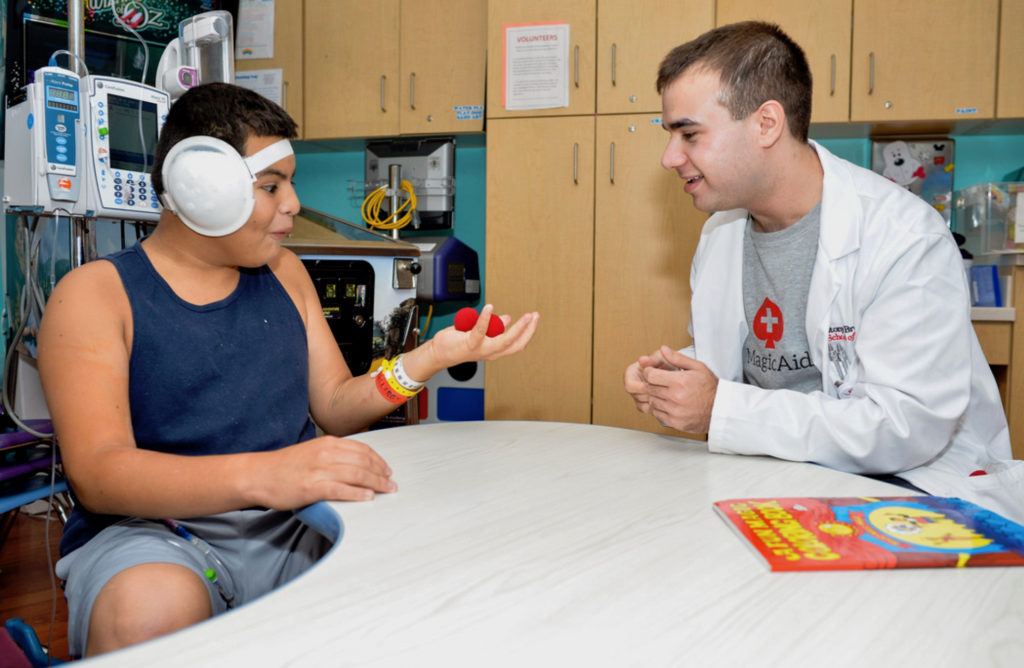The News in Brief:
- Magic therapy provided by Stony Brook medical students significantly reduced the anxiety of pediatric patients and their parents/caregivers by 25 percent.
- Healthcare professionals view magic therapy as highly favorable and a program that should be continued.
- A large majority of patients and parents were interested in magic therapy.
MagicAid magic therapy, is an interactive therapy that uses magic tricks and magic sessions designed to alleviate patient anxiety. MagicAid is a non-profit organization co-founded by Harrison Pravder, a fourth-year medical student at the Renaissance School of Medicine at Stony Brook University. The program is run at Stony Brook Children’s under the guidance of professionals in the Child Life Program.
“It is important to develop tools to facilitate coping and encourage distraction for patients due to anxieties associated with hospitalization,” said Pravder. “Anxiety often arises due to loss of self-determination and separation from home and family in patients, while, for parents, stress is often related to their child’s hospitalization and other concerns such as financial costs, and this stress can translate back to the child.”
Pravder and his colleagues found a majority of patients and parents to be receptive to magic therapy and willing to participate. They evaluated 100 inpatients ages 5 to 16 years and 90 caregivers at Stony Brook Children’s. Patient-caregiver pairs were randomly assigned to a magic therapy intervention group or control group. The magic therapy included a session of watching magic, learning how to perform a magic trick, and receiving a magic prop to practice in order to perform for others.
Anxiety was measured before and after the magic interventions by using validated self-report tools. These included a facial image scale and the venham picture test for younger patients and for older children a pictoral scale and a written scale signifying anxiety levels. Caregivers’ anxiety level was evaluated using only the written linear scale, called the short State-Trait Anxiety Inventory (STAI).
After analyzing the results they found that the patient magic group’s standard anxiety was reduced by 25 percent after the magic therapy, and the caregiver magic group’s anxiety was reduced by 24 percent.
Part of the study included a questionnaire for health professionals designed to assess the usefulness of magic reducing anxiety and the feasibility of such a program in a healthcare setting. Based on the results of 37 physicians and nurses surveyed at Stony Brook on the topic, 98 percent recommended continuance of the program, 97 percent reported that the student magicians were not a disturbance in the healthcare setting, 81 percent reported that the activity is helpful to the child, and 57 percent reported it as helpful to parents.
###
About Stony Brook University
Stony Brook University is going beyond the expectations of what today’s public universities can accomplish. Since its founding in 1957, this young university has grown to become a flagship as one of only four University Center campuses in the State University of New York (SUNY) system with more than 26,000 students and 2,600 faculty members, and 18 NCAA Division I athletic programs. Our faculty have earned numerous prestigious awards, including the Nobel Prize, Pulitzer Prize, Indianapolis Prize for animal conservation, Abel Prize and the inaugural Breakthrough Prize in Mathematics. The University offers students an elite education with an outstanding return on investment: U.S. News & World Report ranks Stony Brook among the top 50 public universities in the nation. Its membership in the Association of American Universities (AAU) places Stony Brook among the top 62 research institutions in North America. As part of the management team of Brookhaven National Laboratory, the University joins a prestigious group of universities that have a role in running federal R&D labs. Stony Brook University is a driving force in the region’s economy, generating nearly 60,000 jobs and an annual economic impact of more than $4.6 billion. Our state, country and world demand ambitious ideas, imaginative solutions and exceptional leadership to forge a better future for all. The students, alumni, researchers and faculty of Stony Brook University are prepared to meet this challenge.
Original post https://alertarticles.info


